4. Classification
There is a fundamental distinction that needs to me made between command centres that are complete solutions, intended to replace two or more decks and a mixer on the one hand, and specialized controllers for specific tasks, for example controlling effects exclusively, on the other. We also distinguish between models with and without integrated audio interfaces. Furthermore, there are some models available which require software to operate them while others come fully operational or offer the choice. Thus, we have come up with the following classification:
- DJ MIDI Controllers without audio interface
- DJ MIDI Controllers with audio interface
- Hybrid DJ controllers with standalone mixing desk function
- Standalone work stations with MIDI Controller function
- Special controllers
- DJ controllers for mobile devices
1. DJ controllers without interface
If you go for a pure DJ controller, the intended use, equipment you may already own, and your own requirements are often the most decisice factors. The question is whether the product is intended to control only part of the DJ software you use, or whether it is intended to control the complete mixing session. Furthermore, it is important to decide whether a pre-listening function should be included, and if so, which interface should be used.
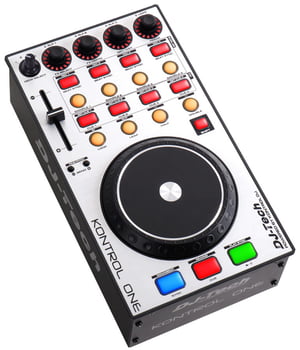
A "deck controller", for example, is intended to be a replacement of or add-on to a CD player or turntable and thus usually features a jog wheel, a tempo fader, and the keys necessary for transport management. It is perfectly suitable for use as an add-on to existing devices; e.g. it can be placed alongside a mixing desk to integrate a digital software deck into the analogue setup. If a controller's intended use is as a replacement mixing desk, it requires some slide controls to fade in, fade out and cross-fade tracks, and there should also be a rotary control for the virtual equalizers. Start, cue and preview buttons should also be featured on the device.
Complete setup simulations are also popular. They merge two decks, a mixer, and controls to select music in a single device. The fully-fledged professional solutions available are often road-worthy metal constructions half a metre or more wide, which often boast touch-sensitive jog wheels for navigation and scratching as well as loop and effects sections. Entry-level users with less space at their disposal and a tighter budget may opt for a micro controller, which features only some basic tools for occasional mixing adventures on their interfaces. Made sometimes mainly of plastics, they are often no bigger than a landscape-format postcard, weigh a lot less, of course, and can be stored in one of the drawers of your computer desk.
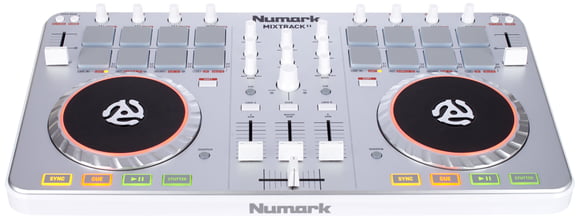
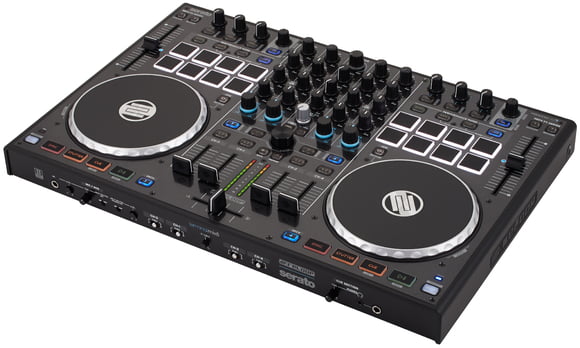
A feature common to DJ controllers without interface is that they are sometimes significantly more affordable than models with built-in sound cards, and that they can be used with most USB audio setups that you may already own. Hobbyists may even want to do without a sound card entirely and therefore connect the DJ tool to the laptop (which then also doubles as a charger through the USB port) without the possibility of pre-listening. Should they wish to pre-listen on a separate output, some DJs will require no more than a monosplit cable, which splits the audio output usually featured on a laptop computer into two outputs, a master and a cue channel. Such a solution, though a compromise, will set you back by much less than €100 and is a good solution if you just want to try out DJing without investing a fortune in equipment right at the start.
For those with professional ambitions, however, an additional audio interface is required, and they'll have to use their own skills in routing the inputs and outputs. In some cases, they'll also need to configure the MIDI commands or generate the so-called mappings, even if software manufacturers often find it useful to support the most popular products available, especially those of their own or their co-operation partners' making. This can be done with automatic configuration, i.e. plug&play, or via download and then manual setup of the configuration file.
If you go for a modular setup for your DJ equipment, you'll end up with a fair number of devices requiring sufficient USB ports on your computer. Some manufacturers therefore also integrate USB hubs in their products, which requires an external power pack to operate the console while having the advantage of not putting too much energy demand on the notebook's USB ports. Modular set-ups certainly offer advantages regarding the flexibility and gurantees that the individual components meet the user's requirements. But the more devices you assemble on a DJ desk, the more potential sources of trouble you assemble as well, rendering the entire system more prone to faults.
2. DJ MIDI controllers with audio interface
These "all-in-one" controllers with built-in audio interfaces are very popular with party, hobby and bedroom DJs. They feature the classic deck-mixer-deck configuration and make for great ease of use, since they are often neatly geared to running the software included. All components are in one casing, so that the only cables necessary are those to connect the controller to the computer, the headphones, and the amplifier. In considering the price, the quality and quantity of the control elements, the creative section for loops the controller comes with, the effects and the live remix options (hot cues, pads, slicing) and, finally, the design of the jog wheels, i.e. size and handling, are important factors.
Entry-level models often offer plenty of options to satisfy ambitious hobby DJs. A central two-channel mixer with library tool and two flanking, sometimes switchable, deck sections are characteristic features, alongside at least one headphone in and a stereo cinch out for the sound system. A mic connection is likewise a frequent feature. At the next-higher level, separate master and cabin outs as well as a second headphone out are standard. Autonomous "emergency" ins (line, less frequently phono) directly routed to the master ensure that the DJ can step in in case their laptop crashes and connect their MP3 player or smartphone. If you can do without a classic mixer without inputs for turntables and CD player(s), and if you are looking for a complete solution that is easy to set up, this is a product category you might want to check out.
3. Hybrid DJ Controllers with standalone mixing desk function
Unlike the DJ workstation we'll discuss below, these come without optical drives, SD Card slots, or USB ports. They are primarily targeted at DJs who want to play music from a laptop while at the same time not wanting to forego working with a classical mixer and want to attach additional drives. The motivations can vary; for example, a DJ may wish to add a digital element to their trusted sources and media - in this case, DJ software and a MIDI controller. Turntablists, for example, can perform their tricks on TC-Vinyl in traditional technique using time-code media and software decks; or they can alternate with real vinyls. Laptop crashes are similarly easy to overcome, since DJs can simply continue in the analogue with CDs and vinyls. They may also use one channel for live instruments, such as a drum computer. Some, but importantly not all, devices in this category are DVS-compatible and enable, as previously mentioned, time-code media control. This depends on the number of USB ins and outs and, where no dongle interface is available, the software manufacturers that support the device.
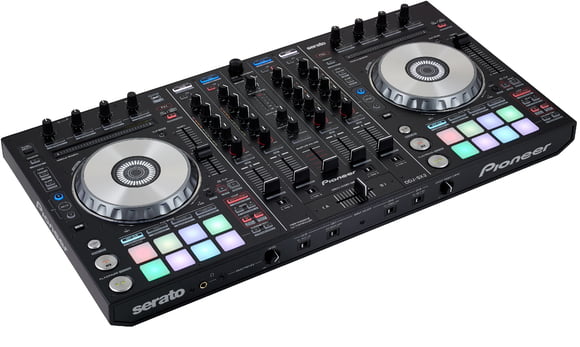
In any case, the two deck section, one on either side, and the obligatory multi-channel mixing desk in the centre are characteristic features. The rear connector panel may feature two, four, or even eight stereo cinch inputs, depending on the model. This depends on how many channel strips the mixer has, and on whether there are separate connections for phono and line sources or combo inputs with selector switches. The obligatory USB interface is available to connect your computer, and the DJ can therefore often switch seamlessly between the software decks and the channels to which the external sources are connected.
So, DJs who who own a large library of optical and analogue media, who want to add a digital component to the drives they have already invested in, or who may want to retire their analogue mixers or control their mp3 files using a digital vinyl system are well served by the flexibility a hybrid DJ controller offers.
4. Standalone work stations with MIDI controller function
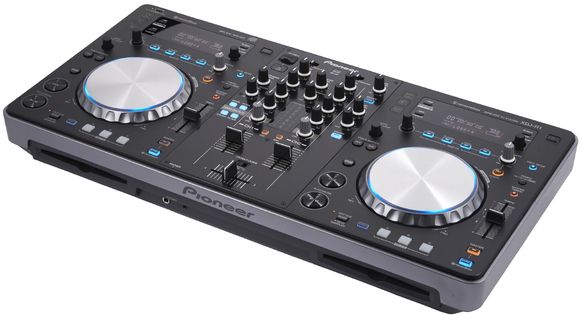
This type of product typically can be used to play back music without the addition of a computer to the setup, meaning that DJ software is not absolutely essential when using it. While CD players predominated in this category even a few years ago, technological progress has not skipped DJ work stations, especially once the digital distribution of media really took of. Current devices boast USB ports and/or SD card slots, some systems also allow for the connection of an iOS device, while still others have gone wireless and use Bluetooth to communicate with a mobile terminal. USB ports for computers are also a standard feature. Due to the fact that removable drives can store many more tracks than audio CDs, some manufacturers have already started to integrate larger and thus more efficient displays that help the DJ keep an overview of the constantly growing amount of data. Add to that encoders and keys for selecting tracks from the CD or stick. The current state-of-the-art all-singing, all-dancing devices include two decks with CD drives, USB ports, a mixing desk, a mic in and an integrated USB audio interface. Frequently, these work stations will also offer the choice of integrating external signals or playing back the player channels separately. The signals are usually fed to the system by symmetric outs and cinch outs. Ideally, the devices have at lest two outs so that alongside the dance floor a second room or space can also be supplied with sound. And the booth out can of course also be used for DJ monitoring.
These still compact, comparatively, all-in-one stations are especially popular with mobile clubs, providers and DJs who have acquired a large music CD collection over the years and/or who have converted it to digital format. They will often easily fit into a compact or medium-sized car and can be set up easily at the venue; they are thus a far more convenient travel companion than individual components. Instructing others how to set them up - especially interesting to equipment rental services - is also less complex than with some individual components. Standalone work stations with MIDI controller function guarantee a certain degree of versatility in case a DJ at a party or a wedding is handed a stick or CD with the hosts' playlist on them. The integrated audio interface ensures even greater flexibility, so that the use of a laptop via the USB port and software controls using the laptop's control devices are ensured. Switching between the software decks, an optical drive or a removable drive can usually be effected seamlessly. Mic ins are a standard feature in this category. Another advantage of this type of device: should the computer crash, plugging in an "emergency stick" or a smartphone is matter of mere seconds.
5. Special controllers
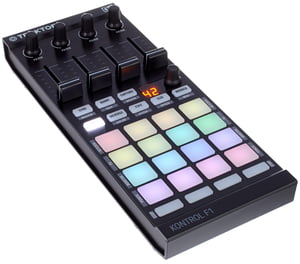
Special controllers frequently feature a completely different design from classic dual deck controllers. As a rule, their task is controlling very specific program functions; they may also, however, be all-rounders, flexible in use thanks to their layout. In this category, you can encounter tools intended for loop and effects control and therefore featuring mainly rotary controls and encoders. There are also models that are equipped with keys to launch samples alongside faders to control the volume of the various sample channels.
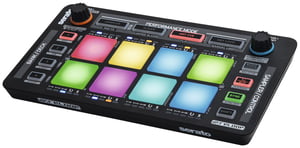
Still others mainly lend themselves to live remixing tasks thanks to their generously proportioned pad matrices and various colour-coded LED lighting statuses. Thus, it is no surprise that alongside the conventional USB tools in vertical or horizontal format which seamlessly connect to the sides or rear of a mixer, there are also more "exotic" models which can, for example, be fastened to the DJ's arm and which use wireless communication, and yet others which are plopped into the space intended for the 45rpm spindle adapter from where they enable selection of cue points. This group of special controllers also includes various fader, grid and rotary controllers or combinations thereof, which often work well not only with a DJ app but also with a DAW such as Ableton Live.
6. DJ controllers for tablets and mobile devices
This category of DJ controllers, having become available only recently, is geared towards compatibility with mobile terminals such as smartphones and tablets. While the first devices were slow in arriving, and compatible only with Apple and its 30-pin adapter, a variety of solutions for iOS and Android have now joined them. The range extends from typical entry-level tools which simply make available the haptic remote control of the app through controls, wheels and faders all the way to products with high-end interfaces for semi-professional users. They are connected to the device via proprietary connectors or, even better, standard cables, and if desired they can also be used on your PC or Mac. If the app you use on the latter is identical to the one you use on your mobile device, you should even be able to synchronize the two via a cloud service.
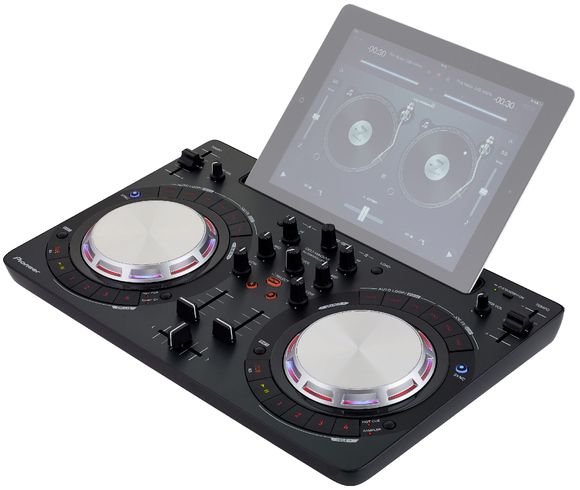
Controllers for tablets and mobile devices make use of two control systems: for example, the user can can control the channel levels, fading, EQ and effect runs in the proven way using his DJ software to precisely control the fader and pot movements; readjustments, scratching and winding within the track is effected using the jog wheel. Further functions, which simply release trigger actions, can be directed via the mobile device's touch panel. In addition, the tablet or phone enables alphabetic searches of the track library, and can communicate with streaming services. If the software is updated and features are added, the DJ need not necessarily use a different controller; they may be able to simply use a sub-page on the tablet. Typical examples for this would be repeat loops in different cycle times, sample players or XY pads for effects control. In comparison to fully-fledged analogue equipment, old hands may consider this type of controller tools for hobby DJs only, but in actual fact they perform identical functions to their "big brothers", only with additional touch control. The performance of tablets is continually improving, and they are rapidly becoming ever more common. If you have a tablet or smartphone and want to use it to play your tracks, these controllers are exactly what you are looking for.
Your Contacts
Product Highlights
-
DJ Controllers
-
DJ Software






